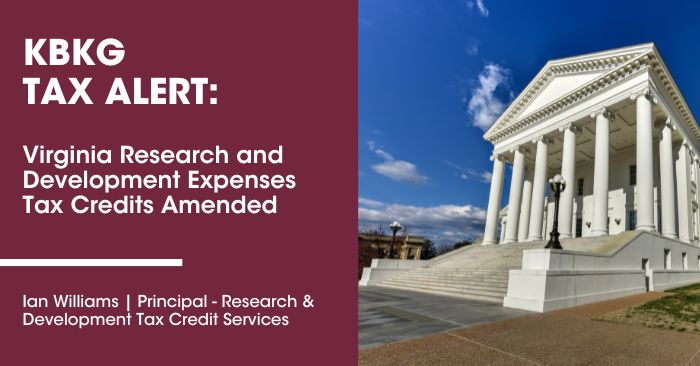KBKG Tax Alert: Virginia Research and Development Expenses Tax Credits Amended
By Ian Williams| Principal, R&D Tax Credits
Effective July 2024, Virginia’s Governor Youngkin signed legislation that impacts Virginia’s major research and development expenses tax credit. The changes include a decreased major R&D expenses cap, a new credit calculation method, and an increased R&D expenses tax credit cap. For tax years 2023-2025, taxpayers with over $5 million in VA qualified R&D expenses are allowed a corporate income, personal income, or bank franchise tax credit equal to 10%, up to $1 million, and 5% of the difference in excess of $1 million, of the difference between the taxpayer’s VA qualified R&D expenses paid or incurred during the taxable year, and 50% of the taxpayer’s average VA qualified R&D expenses for the three preceding tax years. If a taxpayer does not have expenses in any one of those three preceding years, the credit is 5% of VA qualified R&D expenses paid or incurred during the relevant taxable year.
There’s now an annual per-taxpayer cap of $300,000, or $400,000 for research performed in conjunction with certain educational institutions. The aggregate credit cap each fiscal year for the major R&D expenses credit is $16 million, down from $24 million, for taxable years starting 2023. Additionally, the aggregate cap on the R&D expenses tax credit has more than doubled and is raised to $15.77 million, from $7.77 million, for each fiscal year beginning with FY2024.
What is the R&D Tax Credit?
The Research and Development Tax Credit is a reduction in federal tax liability that companies can take for approved domestic expenses. This is a dollar-for-dollar rate of reduction. You also get back approximately 13 cents for every dollar spent on research that meets the eligibility requirements. Qualifying research and development expenses include the development, improvement, or design of a product, technique, process, or software.
This credit can lead to significant savings that free up cash for further R&D, hiring new employees, and more. For companies that meet the criteria of a Qualified Small Business, the R&D credit can be used to offset quarterly payroll taxes. For tax years 2016 through 2022, the maximum R&D tax credit for payroll tax was $250,000. The credit doubled to $500,000 beginning January 1, 2023. Many states have also enacted an R&D credit.
What are the State Benefits?
Aside from the federal R&D tax credit, certain states also offer their own R&D credit for product, process, or software development. While many states align closely with federal rules, some require separate applications and impose industry-specific restrictions or caps on annual credits.
State-level credits can also surpass federal credits, as they may offer higher rates, allow credits to transfer, or even provide cash value regardless of tax liability. Understanding these nuances is crucial to navigating R&D tax credits and ensures taxpayers capture the maximum amount of benefits offered by individual states.


